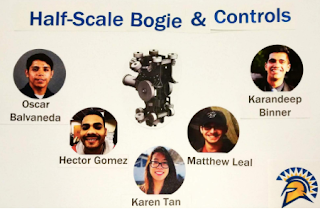Posts
Showing posts from April, 2019
Week 7_ 3/20/19
- Get link
- Other Apps
I purchased the 10 NRFL01 wireless modules on Amazon for $11. We will be using 1 of them for the master bogie. I researched how to set up the modules while they are being shipped and have found example codes for the receiver and transmitter code shown in Figure 1 below and have tried to see if it will work. It seems that the code is sending the "Hello World" text but with noise/ junk between each sent message on the Serial Monitor. Figure 1.a. Receiver module code on Arduino Figure 1.b Transmitter code on Arduino The wiring should be as in Figure 2 below with the supply voltage being 3.3V instead of 5V. Figure 2. Arduino to NRF24L01 wiring This information was found on: https://howtomechatronics.com/tutorials/arduino/arduino-wireless-communication-nrf24l01-tutorial/
Week 5_ 3/6/19
- Get link
- Other Apps
This week I collaborated with the small-scale controls team on their progress with the Xbee programming. I saw that they were still having issues setting up the XTCU software parameters to make the wireless system work. It seems easy enough but there is no complete manual that explains every setting on the software. As of this point, the Xbee modules were not yet purchased. The cost of the Xbees is fairly high compared to other options. The Xbee ranges around $50 each not including the separated necessary components that are needed. We will keep trying different settings to see if any work. The site that has a good amount of information on the Xbee is here: https://www.norwegiancreations.com/2013/10/arduino-tutorial-1-lets-make-xbee-talk/ Seems like the small scale team also says that an antenna is needed to be soldered onto each module, which the chips we found did not have. We will continue collaborating with them for the time being. This week, we also did our first presenta
Week 4_ 2/27/19
- Get link
- Other Apps

The beginning of class consisted of everyone moving the tools and boxes on the floors and tables to designated rooms in the building. We then began individually working on the codes for our part of the project. I completed the team poster and the result is shown in Figure 1 below and began working on the powerpoint for next weeks presentation. Figure 1. Team Poster I found that Arduino has its own serial communication library that is used by the Xbees. The library functions can be found here: https://www.arduino.cc/en/Reference/SoftwareSerial For the code, the Xbee has to have wires that jump from the Rx and Tx of the shield to the Arduino manually and called in the global variables. The serial and xbee serial ports are set to 9600 bps in the setup and if statements control the sending and receiving of data. The starting example code is found here: https://learn.sparkfun.com/tutorials/xbee-shield-hookup-guide?_ga=2.132346503.841101534.1558489646-1921239942.15
Week 3_ 2/20/19
- Get link
- Other Apps
Dr. Furman told us that we are allowed a small space during Maker Faire and would have to shorten the length of the track. A couple of our team members when to the courtyard at SJSU where the half-scale track was being held and found that there is a part that can be easily sectioned off. We will keep 18ft of the track including the slope and y-junction. The legs will also be cut to around 4ft so that the bogie will just hover over the floor. This week, I found a pair of Xbee modules in a box while looking through an unclaimed cabinet brought from the old warehouse. With the 2 S1 edition modules was also an Xbee shield which will be used to fit onto the Arduino. Looking through the Sparkfun website where the Xbees are sold, shows that the module takes in 3.3V and 50mA. The range of the Xbee is 300ft which will be able to accomplish our goals. Figure 1. Xbee module Figure 2. Shield for Arduino It was found that it could have been the Small-sca
Week 2_ 2/13/19
- Get link
- Other Apps

Special guest, Jean, a previous engineer from Bart discussed the possibilities and benefits of having an accelerated transit network. He has recently been developing a code that would manage the individual pods from the pickup area to a destination and provided us with a possible layout of the track that would be most effective. He has proposed to help the small scale team with their project. For the start of this semester, we have decided to designate roles to each person as shown in the image below. Figure 1. List of tasks This semester, we are focused on the automated portion of the bogie. I have decided to take on the wireless communication aspect of the bogie as well as complete the team poster requested by Ron. I began looking into the Xbee module again and found that it required the X-CTU software for control of the module. Different type of Xbees are being researched for possible purchase. Basic parameters on the X-CTU software needed in order for the Xbees' to c
Week 1_ 2/6/19
- Get link
- Other Apps
For the first week of this semester, we were still organizing the new facility and moving our tools around. The new building is larger than the previous in terms of the number of rooms, but the individual rooms are not large and tall enough to house the half and full-scale models. Today, we claimed space and tables in the main meeting room for the half-scale team. Two tables were pushed together for a working area and a third table was placed against the beams to hold the bogie, components, and tools. We found our bogies within the boxes of stuff and was able to set up a computer station with the raspberry pi, monitor, and printer that was found.